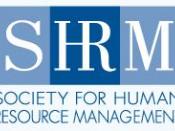IntroductionIt is widely acknowledged and accepted in business that the sources of sustained competitive advantage lie not only in access to finance or capital, but within the organisation, in people and processes capable of delivering business strategies such as customer satisfaction or rapid innovation. (Lundy, 1994). A strategic approach to human resource management (HRM) ensures that a firm's human capital contributes to the achievement of its business objectives. Various influential writers have expressed differing opinions on the importance of employees as a direct influence on an organisations competitive advantage. Although no firm agreement has been reached, it is generally accepted that the use of strategic human resource management (SHRM), (i.e. proactively changing and implementing a series of internal HR policies to ensure effective contribution from a firms human capital to the achievement of business objectives), is relevant within HR intensive firms. 2 Perspectives on HRMStrategic human resource management is often used as the basic framework for the investigation of human resource strategy and its relation to the organisations performance.
Three main theories have been focused on by the top writers on the subject. These are the universalistic, resource-based and configurational perspectives of HRM. Briefly these are: 2.1 Universalistic theory Universalistic perspective is the simplest and most widely used model in literature. Basically, the follower of the universalistic view seeks to instill 'best practices'. That is, they believe some HR practices are always better than others and that firms adopting these practices will experience an improved performance. Seven practices have been identified as 'best'. These are: Good internal career opportunities Formal training systems Results and behavior based appraisals Profit sharing plans Strong employment security Voice mechanisms, e.g. participation in decision making Tightly defined jobs A number of authors have spoken in support of this theory.


